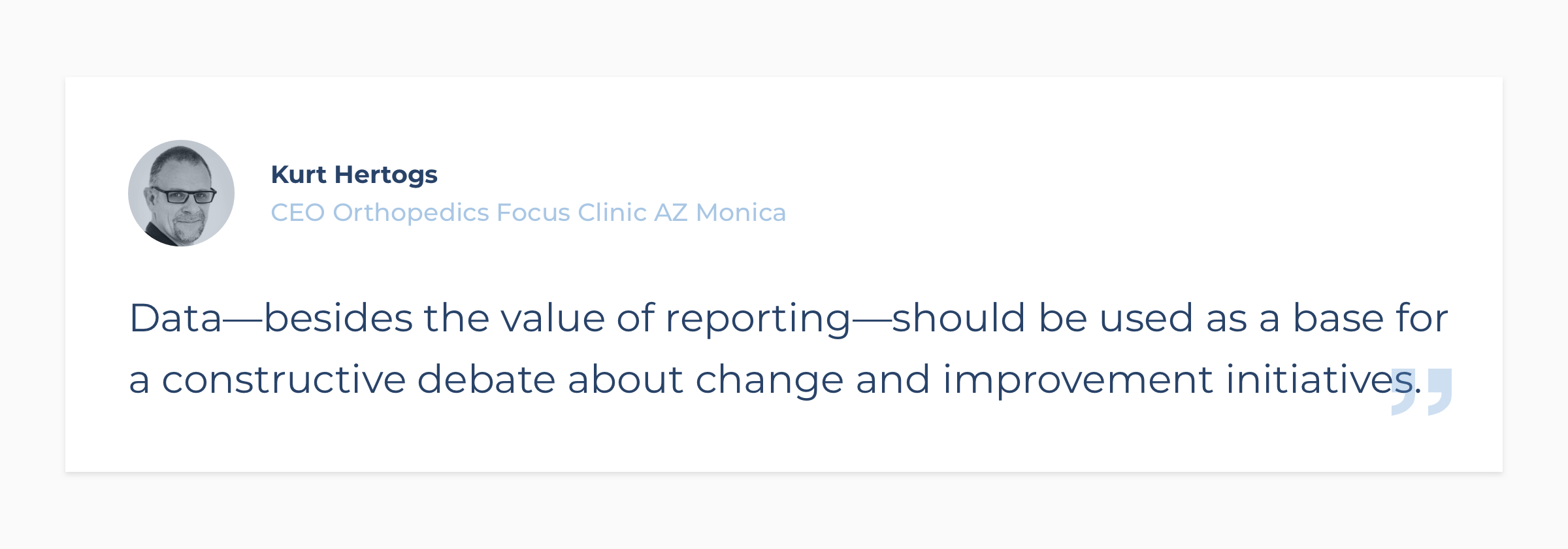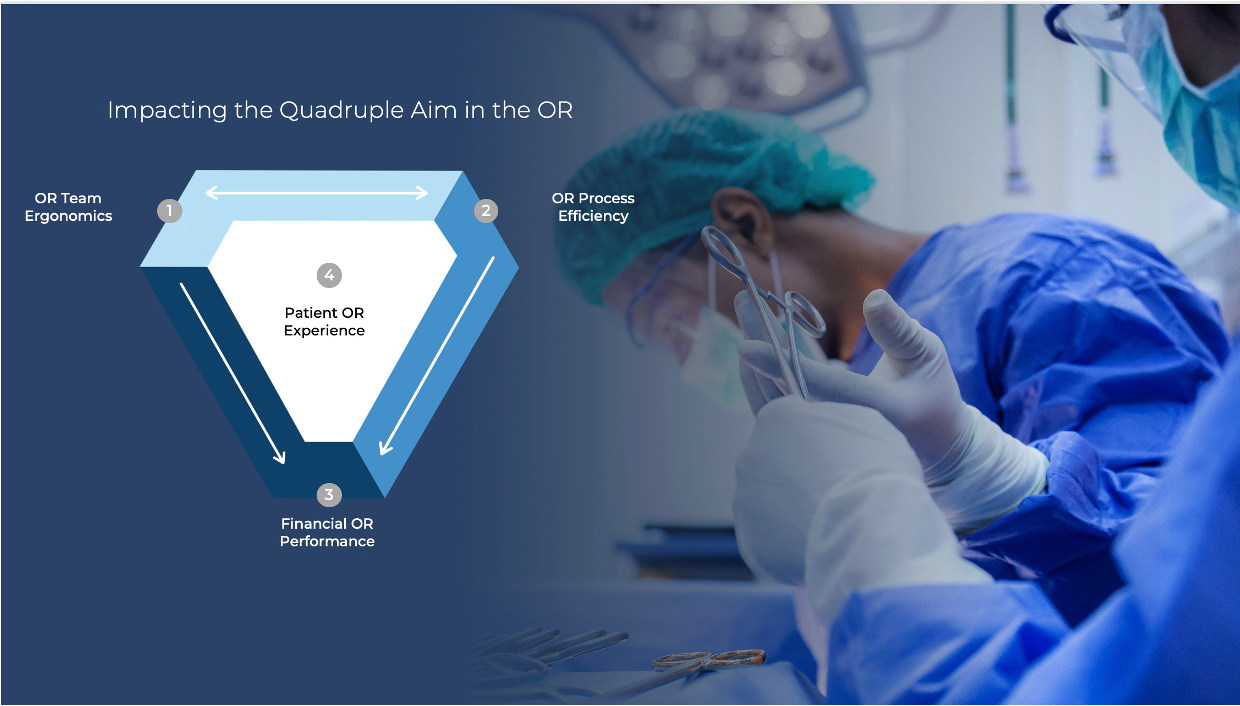Interview: Hospital CEO discusses using data to support decision making
Healthcare innovation, reimbursement pressure, and increased demand challenge hospitals to continuously adapt to a new reality.
Some organizations are already embarking on this journey to prepare for what’s next, be that new healthcare models, technologies, or treatment pathways.
One of such projects is led by Kurt Hertogs, CEO of the Orthopedic Focus Clinic at AZ Monica. He brings a wealth of knowledge from the biotech industry along with an impressive track record of growing and transforming healthcare and life science organizations.
Needless to say, a project of this scope requires alignment between numerous stakeholders to have a chance at success and sustainability.
Internal and external perspectives must be consolidated, and even more so, surgeons, nurses, care teams, and other functional members must be consulted. This is essential to creating a solid foundation for change further down the road.
In an interview with Kurt, he gives his take on how a multitude of viewpoints can be brought together to build common ground using one crucial element: data.
Rethink the traditional data generation model
Historically, the motivation for hospitals to generate data has been to report clinical information to the government.
Coming from the pharmaceutical and life sciences industry and into the hospital, this was a real eye-opener for Kurt, “Countless amounts of data is registered to authorities and tracked for reporting. While the value of reporting data is clear, getting more out of the data to manage and improve operations should be equally clear.
Maybe you’re also interested in: Activity-Based Costing in the Operating Room.
As such, Kurt believes there’s a need to develop insights and include data review into workflows, “Look at the data. What do we see? What can we learn? How can we use these observations to improve and get even better?”
He continues, “Speaking to surgeons and hospital stakeholders, there is no doubt they are ambitious and want to introduce improvements in the operating rooms. However, more often than not, all struggle with the practicalities of the day-to-day operational workload. They don’t have the time, resources, or—and this is important—any quantified objective evidence to bring about such improvements, with the traditional model for data generation not helping them either.”
Kurt explains his reasoning, “On their own, surgeons or surgical teams can’t always convince management about the need for change or suggest improvement ideas if they can’t demonstrate and substantiate what return on investment—in time and effort—such changes could potentially mean.”
Use data to bring people together and build trust
To achieve lasting results, Kurt recognizes the need to bring the entire team—from management and surgeons to OR staff and sterilization unit—together around the same table.
Working together across departments, potentially involving external parties, too, naturally requires some common ground, understanding, and trust. Without this mutual confidence, it’s impossible to take any steps forward.
And this is the part where data plays an extremely critical role.
“Data is a beautiful and powerful means to develop trust, connect people and steer action. It’s about building bridges between people,” explains Kurt.
He adds, “In essence, that’s predominantly what my job has been these past years: to develop sufficient trust among different parties to facilitate impactful change. DEO has been a critical component in making this happen thanks to the thorough data insights they have provided.”
Kurt points out that data is what links it all together. Data—besides the value of reporting—should be used as a base for a constructive debate about change and improvement initiatives.

Quantify OR performances to spell out what are otherwise gut feelings
When stepping into the operating rooms at AZ Monica two years ago, Kurt immediately got a sense of what was working very well and what could have been better, and he’s not alone.
“Any surgical team I speak to immediately sees and senses where improvements can be made. Still, until now, no methodology has been able to quantify the full OR performance and spell out the opportunities we all know are there,” says Kurt.
“Due to a lack of quantifiable insights into OR performance and processes, no one has turned ideas into action, and honestly, surgical teams are not to blame. As I said earlier, it’s the traditional model that’s at fault here, and that’s why it needs rethinking.”
Nevertheless, Kurt is optimistic about what the future holds for new data generation models. “DEO has come up with a unique methodology and a powerful way of quantifying the reality in the OR to make whatever everybody is sensing very tangible.”
“DEO’s model allows surgical teams and hospital management to look at performance and efficiency data in a way that’s very different from the traditional hospital-to-authority-reporting engine. It’s these kinds of comprehensive data insights that are key to build trust and steer change.”
Kurt also highlights how these real and local data insights level out the playing field to welcome change initiatives that are not only management but also surgeon or even team-driven. The result is a much healthier dynamic between teams.

Make everyone in the team feel like a change maker
While data are powerful for bringing people together, data also empower people.
Kurt elaborates, “In the end, we all get to be change makers. Everyone gets a seat at the table and the chance to chime in. And data gives us a tangible starting point to discuss change.”
Forming this good dynamic between different levels in a hospital is vital, according to Kurt. He believes it’s the first step to make teams feel valued and create a fertile ground to start implementing changes later down the road.
Adding to this, he points out how interactions between hospital and non-hospital individuals are extremely valuable for creating a window to the external world that can bring forth new perspectives to foster change internally.
Create a strong business case
Continuing the conversation on engaging everyone in the team, we asked Kurt about using this new data generation model as a basis for creating a business case.
He welcomes this kind of initiative but calls attention to how it must accommodate the specific hospital environment along with the local cost and revenue model.
Kurt also stresses the importance of shared goals, “At the end of the day, a business case is an investment from multiple stakeholders. In a classical hospital setup, the challenge lies in figuring out how both the risk and the rewards are shared fairly. This is not an easy nut to crack, but by making both these investments and gains visible through quantifying them, we can at the very least use it to have an open and objective discussion.”
With these closing words from Kurt, it’s safe to say there’s a world of opportunities lying at the feet of healthcare. The future is bright, and we’re looking very much forward to continue the collaboration with Kurt and AZ Monica to further explore how new models for data generation and insights impact and aid decision-making.
Do you want to know how we can help you get started? Schedule a 15-minute intro call. No strings attached.
PS. If you enjoy this content, you will definitely love the stuff we share on LinkedIn. Make sure you stay in the loop and follow our LinkedIn page.
Add Comment
You must be logged in to post a comment.






